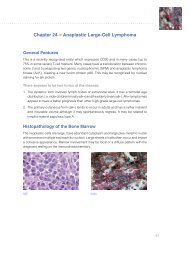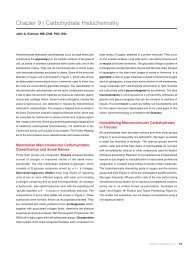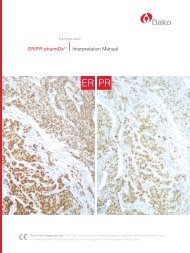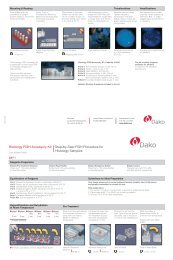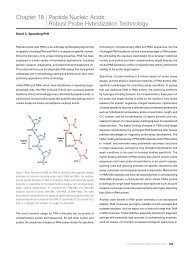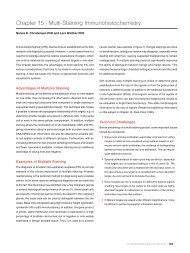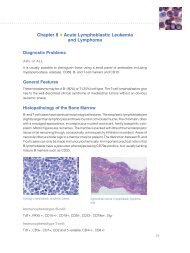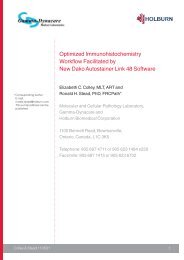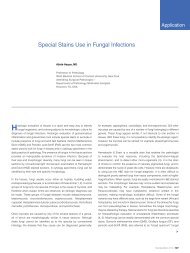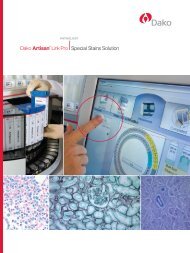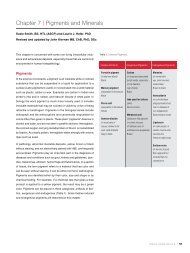Chapter 1 | Introduction to Special Stains - Dako
Chapter 1 | Introduction to Special Stains - Dako
Chapter 1 | Introduction to Special Stains - Dako
You also want an ePaper? Increase the reach of your titles
YUMPU automatically turns print PDFs into web optimized ePapers that Google loves.
<strong>Introduction</strong> <strong>to</strong> <strong>Special</strong> <strong>Stains</strong> <strong>Introduction</strong> <strong>to</strong> <strong>Special</strong> <strong>Stains</strong><br />
Conclusion<br />
special stains belong <strong>to</strong> an assorted family of stains for microscopic<br />
visualization and general identification of cells, tissues and micro-<br />
organisms. special stains remain an important <strong>to</strong>ol for many<br />
pathologists and technologists providing a powerful complement<br />
<strong>to</strong> immunohis<strong>to</strong>chemistry, flow cy<strong>to</strong>metry, in situ hybridization and<br />
other diagnostic technologies that define a patient’s medical profile.<br />
With the medical community demanding greater standardization and<br />
quality control, special stain pro<strong>to</strong>cols have become increasingly<br />
au<strong>to</strong>mated resulting in higher levels of productivity and flexibility.<br />
au<strong>to</strong>mation is no substitute for a solid understanding of the principles<br />
and practices of a quality staining. We anticipate that this technology<br />
will continue <strong>to</strong> evolve in the foreseeable future and expect it <strong>to</strong> form<br />
an integral part of pathologic diagnosis. in a nutshell, this introduction<br />
was intended <strong>to</strong> provide guidance <strong>to</strong> help interested readers acquire<br />
proficiency in selecting and performing special stains faster than they<br />
might have otherwise done.<br />
Appendix<br />
Biological Stain Commission<br />
the Us-based Biological stain commission was an indirect<br />
consequence of World War i. during the Great War there was a<br />
blockade of German products, including dyes. By 1920, the supply of<br />
pre-war dyes was almost exhausted, foreign supplies were erratic, and<br />
the domestic dyes were still often unsatisfac<strong>to</strong>ry. as a consequence,<br />
several concerned groups and individuals came <strong>to</strong>gether, which<br />
resulted in two key conferences in 1921 on the standardization of<br />
stains. From this activity, the commission on the standardization of<br />
Biological stains originated. By 1923, the commission already had<br />
a constitution that is recognizably the forerunner of the aims of the<br />
present commission. in parallel with this, co-founder dr. Harold J.<br />
conn, while chairman of the commission, published the first edition<br />
of Biological stains in 1925. this book has become a standard<br />
source of reference in technical and research his<strong>to</strong>pathological<br />
and biological labora<strong>to</strong>ries using dyes. the book has been revised<br />
regularly with a 10th edition (2002) as the most recent version. in<br />
1944, the commission on the standardization of Biological stains<br />
became the Biological stain commission.<br />
the objectives of the Biological stain commission are: 1) <strong>to</strong> ensure<br />
an uninterrupted supply of dyes used in biological and medical<br />
applications, 2) <strong>to</strong> promote cooperation and dialogue among<br />
manufacturers, vendors and users of dyes for his<strong>to</strong>chemical<br />
applications, 3) <strong>to</strong> ensure the quality of dyes through independent<br />
testing according <strong>to</strong> appropriately rigorous chemical and performance<br />
criteria, 4) <strong>to</strong> educate users of biological stains about sources of<br />
reliable dyes and how they might best be used, and 5) <strong>to</strong> publish<br />
information concerning new or improved uses for biological dyes and<br />
related his<strong>to</strong>chemical techniques.<br />
these objectives are met by way of: 1) analyzing dye content and<br />
composition of samples supplied voluntarily by dye manufacturers<br />
or vendors, 2) testing the performance of dye samples in rigorous,<br />
standardized procedures known <strong>to</strong> be discerning tests of the staining<br />
quality of the dye, 3) issuing certification labels <strong>to</strong> be attached <strong>to</strong> the<br />
containers used by companies marketing accepted dyes <strong>to</strong> assure<br />
consumers that these dyes have met the performance criteria of the<br />
Biological stain commission, 4) conducting and supporting research<br />
on biological dyes and his<strong>to</strong>chemical techniques dependent on dyes,<br />
5) publishing books concerning biological dyes and his<strong>to</strong>chemical<br />
techniques, and publishing Biotechnic & His<strong>to</strong>chemistry, a bimonthly<br />
journal of microtechnique and his<strong>to</strong>chemistry, and 6) maintaining<br />
an active dialogue among scientists, manufacturers and vendors<br />
concerned with biological stains.<br />
interested readers can learn much more about the Biological stain<br />
commission at its Web site: http://www.biologicalstaincommission.org/.<br />
Ana<strong>to</strong>mic Pathology Checklist by College of<br />
American Pathologists<br />
several thousand Us ana<strong>to</strong>mic pathology labora<strong>to</strong>ries are inspected<br />
by the college of american pathologists for accreditation purposes<br />
required by the clinical labora<strong>to</strong>ry improvement amendments of<br />
1988 (clia ’88). they can expect <strong>to</strong> be asked these two questions<br />
about special stains (see text in bold, page 27):<br />
26 | special stains and H & e special stains and H & e | 27



